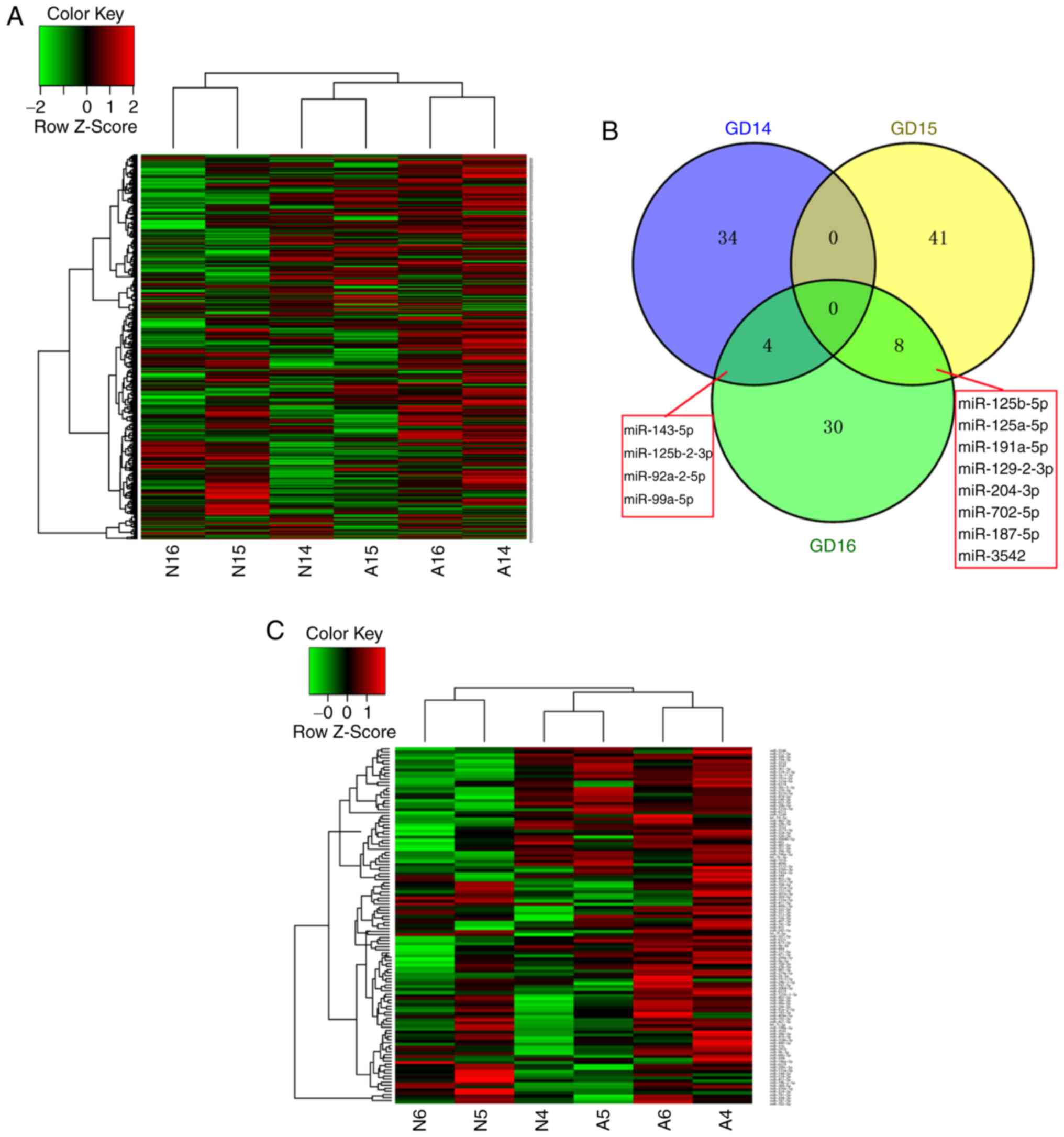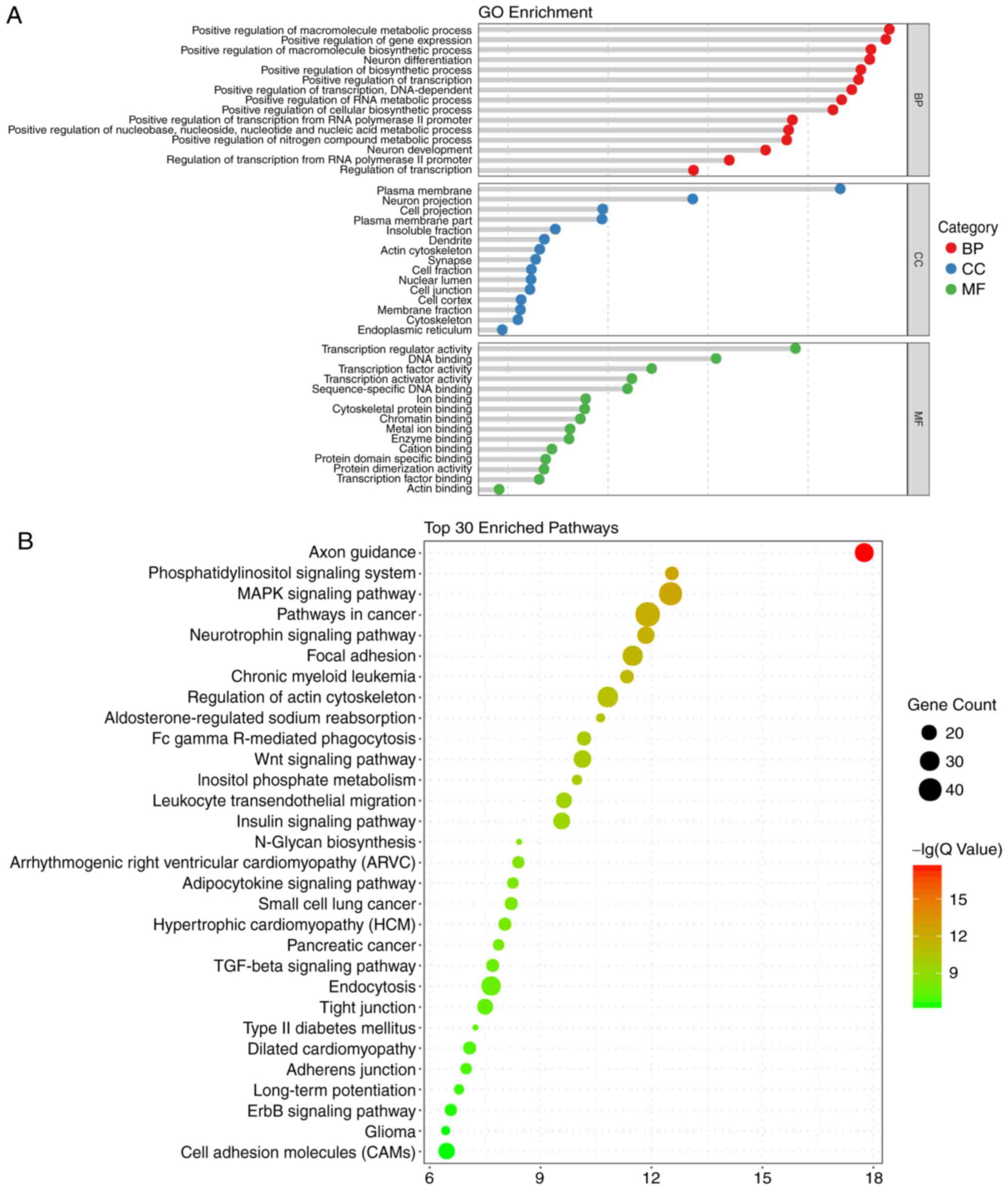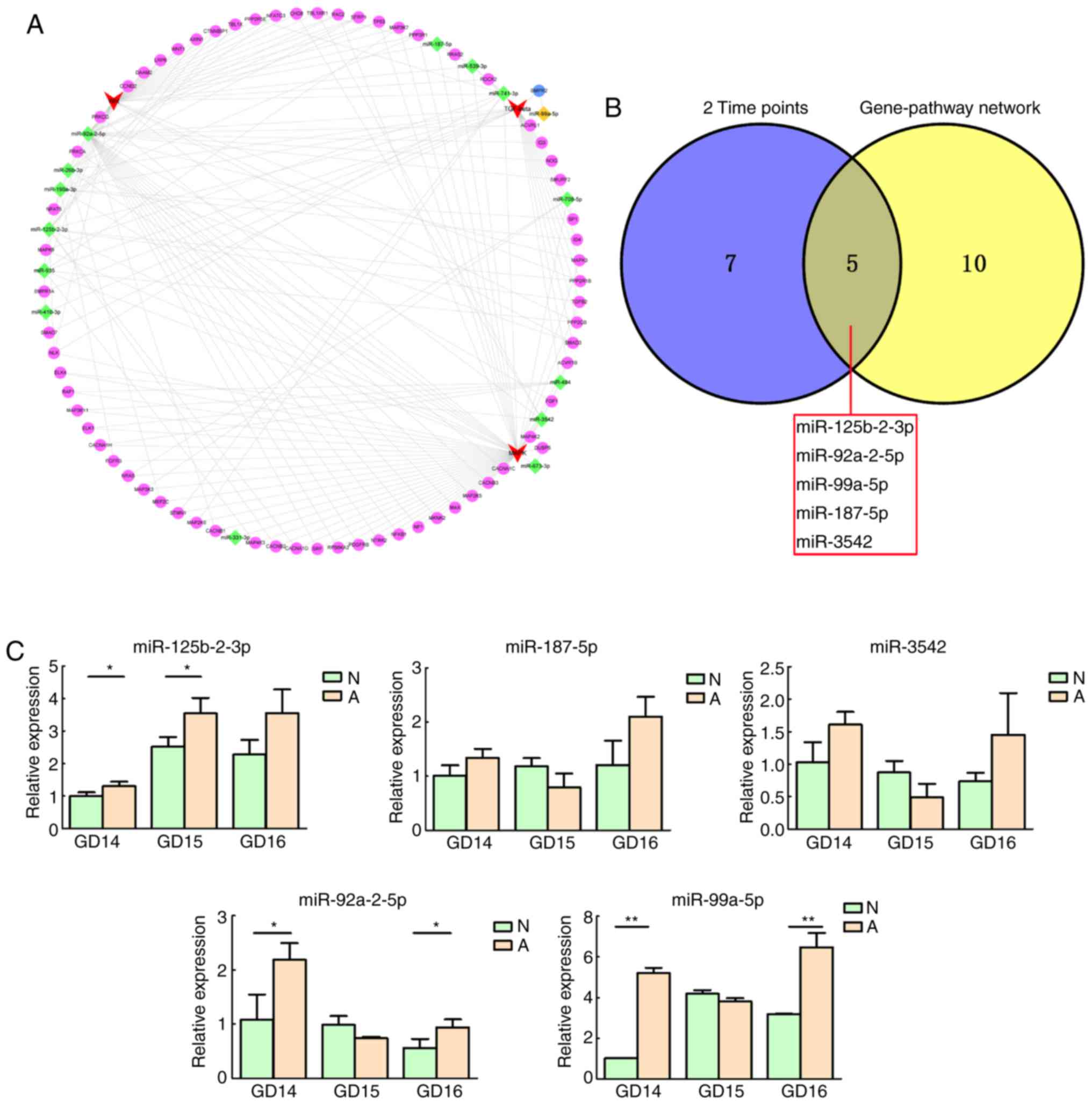|
1
|
Cuschieri A; EUROCAT Working Group:
Descriptive epidemiology of isolated anal anomalies: A survey of
4.6 million births in Europe. Am J Med Genet. 103:207–215. 2001.
View Article : Google Scholar : PubMed/NCBI
|
|
2
|
de Blaauw I, Wijers CH, Schmiedeke E,
Holland-Cunz S, Gamba P, Marcelis CL, Reutter H, Aminoff D,
Schipper M, Schwarzer N, et al: First results of a European
multi-center registry of patients with anorectal malformations. J
Pediatr Surg. 48:2530–2535. 2013. View Article : Google Scholar : PubMed/NCBI
|
|
3
|
Wijers CH, van Rooij IA, Marcelis CL,
Brunner HG, de Blaauw I and Roeleveld N: Genetic and nongenetic
etiology of nonsyndromic anorectal malformations: A systematic
review. Birth Defects Res C Embryo Today. 102:382–400. 2014.
View Article : Google Scholar : PubMed/NCBI
|
|
4
|
Bai Y, Chen H, Yuan ZW and Wang W: Normal
and abnormal embryonic development of the anorectum in rats. J
Pediatr Surg. 39:587–590. 2004. View Article : Google Scholar : PubMed/NCBI
|
|
5
|
Grano C, Bucci S, Aminoff D, Lucidi F and
Violani C: Quality of life in children and adolescents with
anorectal malformation. Pediatr Surg Int. 29:925–930. 2013.
View Article : Google Scholar : PubMed/NCBI
|
|
6
|
Draaken M, Prins W, Zeidler C, Hilger A,
Mughal SS, Latus J, Boemers TM, Schmidt D, Schmiedeke E, Spychalski
N, et al: Involvement of the WNT and FGF signaling pathways in
non-isolated anorectal malformations: Sequencing analysis of WNT3A,
WNT5A, WNT11, DACT1, FGF10, FGFR2 and the T gene. Int J Mol Med.
30:1459–1464. 2012. View Article : Google Scholar : PubMed/NCBI
|
|
7
|
Dong R, Shen Z, Zheng C, Chen G and Zheng
S: Serum microRNA microarray analysis identifies miR-4429 and
miR-4689 are potential diagnostic biomarkers for biliary atresia.
Sci Rep. 6:210842016. View Article : Google Scholar : PubMed/NCBI
|
|
8
|
Liang G, Malmuthuge N, McFadden TB, Bao H,
Griebel PJ, Stothard P and Guan le L: Potential regulatory role of
microRNAs in the development of bovine gastrointestinal tract
during early life. PLoS One. 9:e925922014. View Article : Google Scholar : PubMed/NCBI
|
|
9
|
Jin S, Wang J, Chen H and Xiang B:
Differential miRNA expression analysis during late stage terminal
hindgut development in fetal rats. J Pediatr Surg. 52:1516–1519.
2017. View Article : Google Scholar : PubMed/NCBI
|
|
10
|
Li S, Wang S, Guo Z, Wu H, Jin X, Wang Y,
Li X and Liang S: miRNA profiling reveals dysregulation of RET and
RET-regulating pathways in Hirschsprung's disease. PLoS one.
11:e01502222016. View Article : Google Scholar : PubMed/NCBI
|
|
11
|
Monzo M, Navarro A, Bandres E, Artells R,
Moreno I, Gel B, Ibeas R, Moreno J, Martinez F, Diaz T, et al:
Overlapping expression of microRNAs in human embryonic colon and
colorectal cancer. Cell Res. 18:823–833. 2008. View Article : Google Scholar : PubMed/NCBI
|
|
12
|
Macedo M, Martins JL and Meyer KF:
Evaluation of an experimental model for anorectal anomalies induced
by ethyl-enethiourea. Acta Cir Bras. 22:130–136. 2007. View Article : Google Scholar : PubMed/NCBI
|
|
13
|
Qi BQ, Beasley SW and Frizelle FA:
Clarification of the processes that lead to anorectal malformations
in the ETU-induced rat model of imperforate anus. J Pediatr Surg.
37:1305–1312. 2002. View Article : Google Scholar : PubMed/NCBI
|
|
14
|
Faria DJ, Simões Mde J and Martins JL: Is
it possible folic acid reduce anorectal malformations
ethylenethiourea induced in rats? Acta Cir Bras. 30:517–522. 2015.
View Article : Google Scholar : PubMed/NCBI
|
|
15
|
National Research Council (US) Committee
for the Update of the Guide for the Care and Use of Laboratory
Animals: Guide for the Care and Use of Laboratory Animals. 8th
edition. National Academies Press; Washington, DC: 2011
|
|
16
|
Kohl M, Wiese S and Warscheid B:
Cytoscape: Software for visualization and analysis of biological
networks. Methods Mol Biol. 696:291–303. 2011. View Article : Google Scholar
|
|
17
|
Livak KJ and Schmittgen TD: Analysis of
relative gene expression data using real-time quantitative PCR and
the 2(−Delta Delta C(T)) method. Methods. 25:402–408. 2001.
View Article : Google Scholar
|
|
18
|
Zhou X, Wang J, Sun H, Qi Y, Xu W, Luo D,
Jin X, Li C, Chen W, Lin Z, et al: MicroRNA-99a regulates early
chondrogenic differentiation of rat mesenchymal stem cells by
targeting the BMPR2 gene. Cell Tissue Res. 366:143–153. 2016.
View Article : Google Scholar : PubMed/NCBI
|
|
19
|
Wang C, Li L and Cheng W: Anorectal
malformation: The etiological factors. Pediatr Surg Int.
31:795–804. 2015. View Article : Google Scholar : PubMed/NCBI
|
|
20
|
Wong EH, Ng CL, Lui VC, So MT, Cherny SS,
Sham PC, Tam PK and Garcia-Barceló MM: Gene network analysis of
candidate loci for human anorectal malformations. PLoS One.
8:e691422013. View Article : Google Scholar : PubMed/NCBI
|
|
21
|
Nakamura T, Tsuchiya K and Watanabe M:
Crosstalk between Wnt and Notch signaling in intestinal epithelial
cell fate decision. J Gastroenterol. 42:705–710. 2007. View Article : Google Scholar : PubMed/NCBI
|
|
22
|
Lei H, Tang J, Li H, Zhang H, Lu C, Chen
H, Li W, Xia Y and Tang W: MiR-195 affects cell migration and cell
proliferation by downregulating DIEXF in Hirschsprung's disease.
BMC Gastroenterol. 14:1232014. View Article : Google Scholar
|
|
23
|
Park C, Yan W, Ward SM, Hwang SJ, Wu Q,
Hatton WJ, Park JK, Sanders KM and Ro S: MicroRNAs dynamically
remodel gastrointestinal smooth muscle cells. PLoS One.
6:e186282011. View Article : Google Scholar : PubMed/NCBI
|
|
24
|
Tang W, Tang J, He J, Zhou Z, Qin Y, Qin
J, Li B, Xu X, Geng Q, Jiang W, et al:
SLIT2/ROBO1-miR-218-1-RET/PLAG1: A new disease pathway involved in
Hirschsprung's disease. J Cell Mol Med. 19:1197–1207. 2015.
View Article : Google Scholar : PubMed/NCBI
|
|
25
|
Matsumaru D, Murashima A, Fukushima J,
Senda S, Matsushita S, Nakagata N, Miyajima M and Yamada G:
Systematic stereoscopic analyses for cloacal development: The
origin of anorectal malformations. Sci Rep. 5:139432015. View Article : Google Scholar : PubMed/NCBI
|
|
26
|
Wang W, Jia H, Zhang H, Chen Q, Zhang T,
Bai Y and Yuan Z: Abnormal innervation patterns in the anorectum of
ETU-induced fetal rats with anorectal malformations. Neurosci Lett.
495:88–92. 2011. View Article : Google Scholar : PubMed/NCBI
|
|
27
|
Guan K, Li H, Fan Y, Wang Y and Yuan Z:
Defective development of sensory neurons innervating the levator
ani muscle in fetal rats with anorectal malformation. Birth Defects
Res A Clin Mol Teratol. 85:583–587. 2009. View Article : Google Scholar : PubMed/NCBI
|
|
28
|
Mandhan P, Quan QB, Beasley S and Sullivan
M: Sonic hedgehog, BMP4, and Hox genes in the development of
anorectal malformations in Ethylenethiourea-exposed fetal rats. J
Pediatr Surg. 41:2041–2045. 2006. View Article : Google Scholar : PubMed/NCBI
|
|
29
|
Zhang J, Tang XB, Wang WL, Yuan ZW and Bai
YZ: Spatiotemporal expression of BMP7 in the development of
anorectal malformations in fetal rats. Int J Clin Exp Pathol.
8:3727–3734. 2015.PubMed/NCBI
|
|
30
|
Pyati UJ, Cooper MS, Davidson AJ,
Nechiporuk A and Kimelman D: Sustained Bmp signaling is essential
for cloaca development in zebrafish. Development. 133:2275–2284.
2006. View Article : Google Scholar : PubMed/NCBI
|
|
31
|
Ng RC, Matsumaru D, Ho AS, Garcia-Barceló
MM, Yuan ZW, Smith D, Kodjabachian L, Tam PK, Yamada G and Lui VC:
Dysregulation of Wnt inhibitory factor 1 (Wif1) expression resulted
in aberrant Wnt-β-catenin signaling and cell death of the cloaca
endoderm, and anorectal malformations. Cell Death Differ.
21:978–989. 2014. View Article : Google Scholar : PubMed/NCBI
|
|
32
|
Miyagawa S, Harada M, Matsumaru D, Tanaka
K, Inoue C, Nakahara C, Haraguchi R, Matsushita S, Suzuki K,
Nakagata N, et al: Disruption of the temporally regulated cloaca
endodermal β-catenin signaling causes anorectal malformations. Cell
Death Differ. 21:990–997. 2014. View Article : Google Scholar : PubMed/NCBI
|
|
33
|
Stevens ML, Chaturvedi P, Rankin SA,
Macdonald M, Jagannathan S, Yukawa M, Barski A and Zorn AM: Genomic
integration of Wnt/β-catenin and BMP/Smad1 signaling coordinates
foregut and hindgut transcriptional programs. Development.
144:1283–1295. 2017. View Article : Google Scholar : PubMed/NCBI
|
|
34
|
Jevnaker AM, Khuu C, Kjøle E, Bryne M and
Osmundsen H: Expression of members of the miRNA17-92 cluster during
development and in carcinogenesis. J Cell Physiol. 226:2257–2266.
2011. View Article : Google Scholar
|
|
35
|
Ouchi Y, Yamamoto J and Iwamoto T: The
heterochronic genes lin-28a and lin-28b play an essential and
evolutionarily conserved role in early zebrafish development. PLoS
One. 9:e880862014. View Article : Google Scholar : PubMed/NCBI
|
|
36
|
Kim KH, Seo YM, Kim EY, Lee SY, Kwon J, Ko
JJ and Lee KA: The miR-125 family is an important regulator of the
expression and maintenance of maternal effect genes during
preimplantational embryo development. Open Biol. 6:1601812016.
View Article : Google Scholar : PubMed/NCBI
|
|
37
|
Ambros V: MicroRNAs and developmental
timing. Cur Opin Genet Dev. 21:511–517. 2011. View Article : Google Scholar
|
|
38
|
Malmevik J, Petri R, Klussendorf T, Knauff
P, Åkerblom M, Johansson J, Soneji S and Jakobsson J:
Identification of the miRNA targetome in hippocampal neurons using
RIP-seq. Sci Rep. 5:126092015. View Article : Google Scholar : PubMed/NCBI
|
|
39
|
Yin H, Sun Y, Wang X, Park J, Zhang Y, Li
M, Yin J, Liu Q and Wei M: Progress on the relationship between
miR-125 family and tumorigenesis. Exp Cell Res. 339:252–260. 2015.
View Article : Google Scholar : PubMed/NCBI
|
|
40
|
Tong Z, Liu N, Lin L, Guo X, Yang D and
Zhang Q: miR-125a-5p inhibits cell proliferation and induces
apoptosis in colon cancer via targeting BCL2, BCL2L12 and MCL1.
Biomed Pharmacother. 75:129–136. 2015. View Article : Google Scholar : PubMed/NCBI
|
|
41
|
Chen D, Chen Z, Jin Y, Dragas D, Zhang L,
Adjei BS, Wang A, Dai Y and Zhou X: MicroRNA-99 family members
suppress Homeobox A1 expression in epithelial cells. PLoS One.
8:e806252013. View Article : Google Scholar : PubMed/NCBI
|
|
42
|
Emmrich S, Rasche M, Schöning J, Reimer C,
Keihani S, Maroz A, Xie Y, Li Z, Schambach A, Reinhardt D and
Klusmann JH: miR-99a/100-125b tricistrons regulate hematopoietic
stem and progenitor cell homeostasis by shifting the balance
between TGFbeta and Wnt signaling. Genes Dev. 28:858–874. 2014.
View Article : Google Scholar : PubMed/NCBI
|












